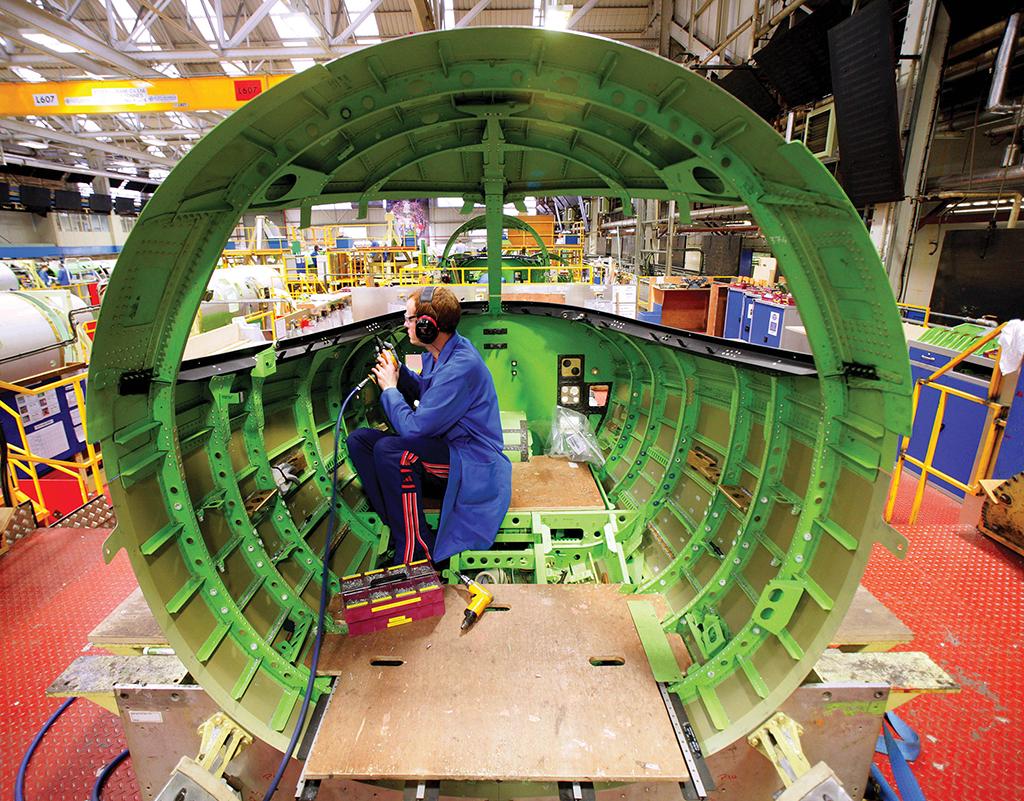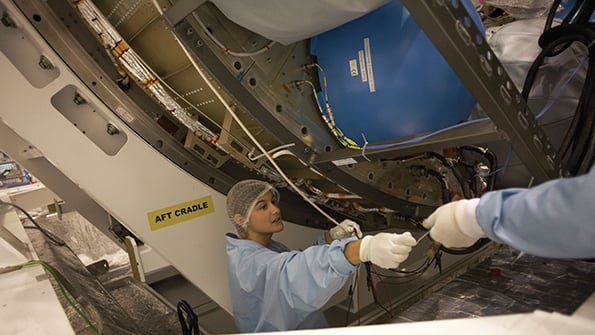
The most dramatic supply chain spending over the next year could occur around talent acquisition, according to the survey.
Three years into the aerospace and defense industry’s recovery from the COVID-19 pandemic—which caused the worst downturn in commercial aviation’s history and touched off the current spate of supply chain struggles—relationships between large OEMs and suppliers are in relatively good health, a market survey from Aviation Week and Bank of America shows.
Asked whether they would characterize their company’s relationship with customers as in good health, 42% of respondents said they agreed somewhat or strongly, while 37% gave a neutral response. Just 21% of those surveyed disagreed with the premise of the question a little or a lot.
- OEMs and prime customers are accommodating many suppliers
- Workforce shortage is a top concern, but access to talent is not
Similarly, when asked how healthy their relationship was with their own suppliers, respondents again skewed favorably, with 36% agreeing that their business relationships are in good health and the same percentage neutral on the statement. Those that reported some level of disagreement, indicating strained relationships with their suppliers, accounted for 28%.
The results may surprise casual observers, based on the torrent of reports and commentary from all levels of industry on how supply chain letdowns are limiting the sector’s output. There even have been occasional public spats.
Honeywell International managers said April 27 during their latest quarterly financial report that they—like everyone else in the industry—were laboring through supply chain challenges. But in an unusual moment, CEO Darius Adamczyk was forced to respond to direct complaints that Honeywell has been a problem supplier.
The day before, in her own company’s quarterly report, General Dynamics Chairman and CEO Phebe Novakovic called out Honeywell: “The shortage of parts to schedule from the supply chain, especially from Honeywell, has created significant out-of-station work, which is inherently less efficient.”
In response, Adamczyk explained it was not Honeywell so much as some of its own suppliers that were a challenge. “We have a lot of issues with our supply base as well,” he said, noting that it is a common problem among large public companies. Honeywell has four or five layers of suppliers and has had to send “hundreds” of its own employees to subcontractors to help them fix challenges.
“I’m not going to sit here and call them out,” he added. “Frankly, it’s our responsibility, and it’s our job to deliver, and I am not going to use somebody else as an excuse for us not to manage. An earnings call is not the right place to have those kinds of discussions, so we’re going to work at it. We own it.
“I know the supply chain in aerospace is not perfect. It is getting better, and it’s getting better relatively quickly—probably even better than we anticipated,” Adamczyk continued. “But there is work to do.”
For sure, Novakovic was emphasizing for her stakeholders that out-of-station work is more challenging for post-pandemic employees, many of whom are less experienced than veteran workers who left in the “great resignation.”
Still, it is uncommon for large companies to single each other out publicly. Indeed, in their own recent earnings calls, the CEOs of both Boeing and its largest supplier, Spirit AeroSystems, overtly complimented one another’s companies as they labor to work through a tail fin assembly issue, the latest setback to slow down 737 MAX deliveries.
However, Bank of America analyst Ronald Epstein tells Aviation Week that reports of relatively healthy relationships make sense—despite deep supply chain struggles and lost revenue. “If you’re trying to build an airplane, you need the whole plane, so if 95% of your supply chain is working . . . then 95% of it feels good,” he says. “But that 5% that doesn’t, that’ll hold you up.”
Respondents to the survey listed several ways customers have been accommodating amid supply chain issues, including accepting delays, price increases, less onerous payment terms and holding inventory. But some comments note that these actions also were logical moves in response to challenges that OEMs and large prime contractors are facing themselves.
“In general, we are finding our business terms and lead times are helping the primes, so payment terms and holding inventory is being enabled by the prime,” one respondent said.
Others stressed that there are still choke points. “It was mixed during the pandemic and associated supply chain shortages, with some customers being flexible [while] others were not,” one commenter said.
“If anything, they are less accommodative,” another respondent said about customers.
Indeed, there remains a lot to lament. “Supply chain normalization is still going to take a while,” Epstein said.
Asked when they expect supply chain issues to be fully resolved, 47% of respondents said 2025, and 22% said 2024. Just 4% said 2023, while 14% and 13% said 2026 or 2027, respectively. Asked if their supply chain organization has a clear line of sight on 2023 production levels, 40% disagreed, 35% agreed, and 25% said their view was neutral.
“That one honestly surprised me a little bit,” Epstein said of the survey results. “Because I thought in 2023 they would have a better line of sight by now.”
Asked where they expect to see the most dramatic supply chain spending over the next year, 26% said talent acquisition, whereas 22% said building inventory. Digital and automation tools were cited by 18%, and supporting suppliers was listed at the top by just 15%. Raw materials were mentioned by 13% of those surveyed.

Recruiting and retaining workers was a common concern across survey responses. Interestingly, respondents indicated that widely reported layoffs in the technology sector have not translated into significantly easier or better hiring in aerospace and defense. More than half of respondents were neutral on the question of eased constraints due to the tech layoffs, and 35% disagreed outright. Just 11% agreed.
That does not shock Epstein. “If you’re working at Google, you’re not going to go buck rivets,” he says.
Nevertheless, survey respondents expressed optimism about recruiting and retaining skilled workers, with 55% indicating they can attract talent and 59% saying they can keep them.
The survey was conducted this spring and counted roughly 140 respondents per question. Slightly more than 50% represented a company or business unit that records less than $25 million in annual revenue, but 14% were companies notching billions of dollars. Almost 60% were in the U.S., although nearly 30 other countries were included. By type, 16% identified as a maintenance, repair and overhaul provider, 12% electronics or avionics, 12% engineering services, 7% metals and 5-6% each for aeromechanical, airframe systems, aerostructures, and castings and forgings.





